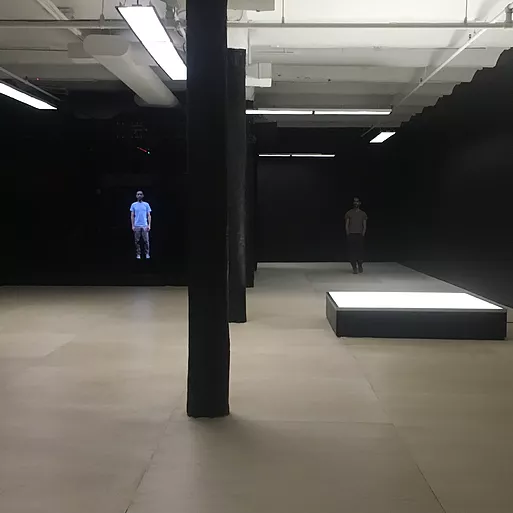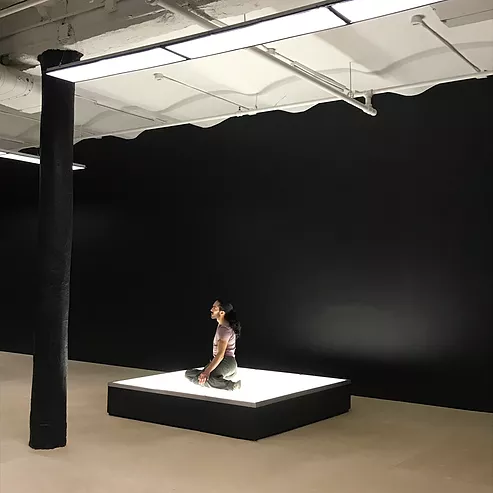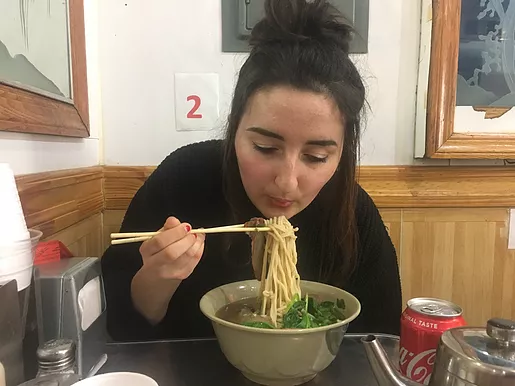Alexandra Pirici @ the New Museum
GDLP + ZM
Emoji summary: 🔘🔆🕴
galleries are holes in a city, they are dark vacuums you fall into, away from air and sky. i see them very literally as holes I think, like I hold my breath as I walk into them so when I leave it often feels like relief. I don’t think it’s just the institutional or cultural pressure that makes that discomfort, a big part of it is how weird art is in the first place. I haven’t seen enough david attenborough to say this for sure-for sure, but no other animal arranges colours, shapes and sounds in a room and then invites other animal peers to come and look at what they have done and talk about how they have behaved. Art is pernickety, v strange, and that’s where we’re coming from when we write our exhibition reviews, always figuring that out. that stance was urgent on my mind this week with us being in the US, specifically new york, a hyper city: all straight lines n posture. We were at the New Museum and saw the rooms showing the Triennial (big art exhibition they put on every 3 years) but it made me feel like a tired alien wondering why humans do art in the first place. but!
outside of the triennial and at the bottom of the museum next 2 the foyer was a long dark room with an installation by artist Alexandra Pirici, called ‘Co-natural.’ There was a square light box on the floor and across from that a transparent pyramid with a hologram projected n trapped inside, of a man in a blue t shirt, standing, full length;; in silence he moves. I didn’t watch him, he slipped through my gaze tbqh, because from behind the pyramid a person emerged, singing. it was wild but imagine I am whispering ‘wild’ because of the level of that sound. Its quality was full, choral, streaming out of this body-mouth and somehow so casual? it was operatic and sad and very quickly I remembered ‘oh, yeah, I do like art’ (because where the triennial had the visitor stepping from piece to piece between art that was protectively LOCATED inside its own skin and stubbornly so - Pirici’s installation downstairs was inside out, its edges were flapping in the wind. It had the right conditions to allow for a transformative aesthetic experience, disssss-located suddenly, n i was falling down the art hole but happily for once because i always feel like that type of aesthetic experience happens to you rather than seeing a very contained Art and u having to work on yourself so you can happen to it/ and activate its meaning. this was open).
the invigilator was smiling at me smiling at the room so we got talking, and he told me the performers change depending on the time n day - when we went it was Miguel Angel Guzmán singing. angel angel angel. The invigilator said everyone loves Miguel, and I can’t tell you the words the performer sang,, a language i don’t understand;;; I love how when that happens, specificity dissolves into sound plus feeling. their voice filled the room around the objects and the people within it, inhabiting empty space well, filling up around us like water does to a body in a bath. [this review has to be specific to the performer that day whose voice had a certain weight in the space that was not quite presence, but like/././. it took up space, it was tangible. Have u ever seen Sonia Boyce’s For You, Only You? I think about that work a LOT, the way sound fills up, this beautiful wholeness that can only rly happen with the human voice. i wrote about this a bit at the beginning of my review of Manni Sandhu’s Welcome to the Future; if u didn’t read it (obviously, do: link) where i said, ‘All instruments do is one or two, maybe three different flavours of sound. The human voice stretches into any and every flavour. It has a malleable quality; when someone sings, even against a full orchestra, there is still space for the human voice in a cacophony of noise. It has the ability to assume rather than be; it can adjust, bend in a way nothing man-made can. It can sit, glimmering, like a jewel in the mud.’ this says what i want to articulate about the way the human voice can command space, bc that’s what this performance kinda did].
I liked that the hologram person in the pyramid was banal, part of the furniture in a way that meant the digitality of the installation was banal; that we can use technology in our vocabulary towards other feelings without getting stuck on unpicking the digital itself; part of experience enough now that we admit how we harness it. the light box was sometimes a stage that Miguel stood or sat on for a moment /, every so often becoming a statue/ between his general movement round the gallery space. As a whole installation, the work was v calm and confident in a way I enjoy. Like, while we’ve been in New York, we’ve eaten a lot of food 2 the point it has basically been a gastroholiday. Pirici’s work made me think of a tiny restaurant we went to this week in China Town called Tasty Hand Pulled Noodles Inc. where we had bowls of broth with hand pulled noodles, and it was -enough-. Have u had bread so fresh and right on its own that you don’t even want any spread? bc with those noodles you didnt need a topping, didn’t expect or miss meat as a part of the event of the dish. When literal components are good through and through, made with care and practiced and given to u cleanly, you don’t need anything more. it is nice ! when things rest on that level: slight, minimal confidence in knowing when to stop or how much is enough to leave you satisfied but not full-up in a bad way. There were exhibition visitors sitting all around the space in awe and the art made us stay too bc here was recovery from the triennial noise, from city noise, from everything being bigger than i’d ever seen before. I appreciated Pirici’s work so much. slowly, quietly confident; a happy wholeness.


